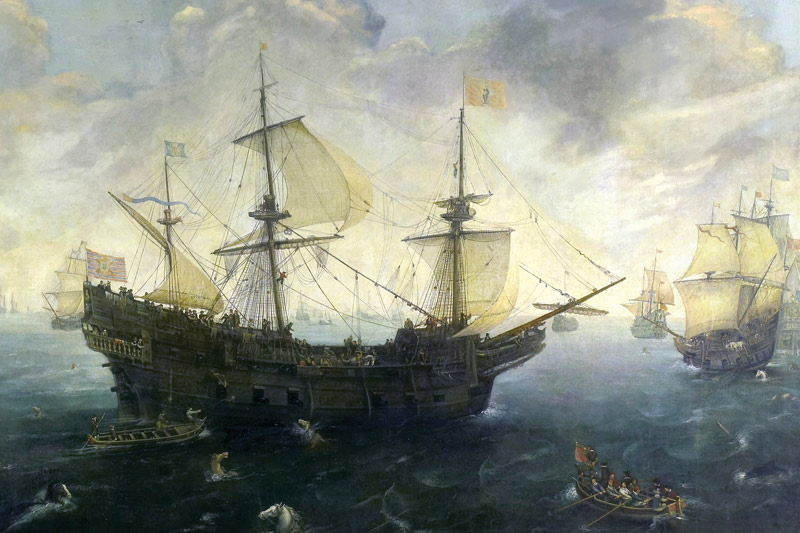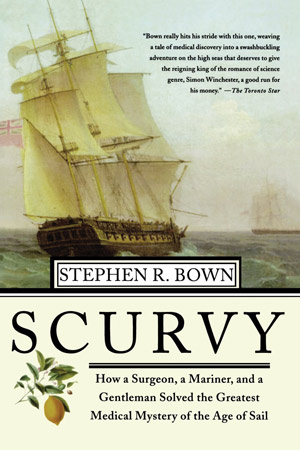
Scurvy by Stephen R. Bown
It’s a running joke onboard our boat as we stock the fridge with limes for evening cocktails that we are staving off scurvy. We have a related joke about the quinine in tonic water and our brave battle against malaria here in Seattle. What makes the scurvy joke actually tragic is that our “cure” for the disease is the actual cure for the disease. If 18th century merchant mariners and naval captains had known and had been able to carry stores of citrus onboard, scurvy would never have become a problem, and the world would be a very different place.
Stephen R. Bown’s book Scurvy: How a Surgeon, a Mariner, and a Gentleman Solved the Greatest Medical Mystery of the Age of Sail is a part nautical history, part scientific treatise, and part medical detective story. Those combine to make for a very enjoyable onboard read.
Bown opens by showing readers the truly horrific conditions aboard 18th century sailing ships (and the equally horrific conditions on land for most of the sailors pressed into service). Piece by piece, he sets the table on the way to explaining how the nature of seafaring, the competition among naval forces, and the quest to unlock faraway lands all conspired to keep the diagnosis of scurvy and its subsequent cure just out of view, but right under everyone’s nose.
As much as I am drawn to narratives about sailing ships of old and tales of men like Captain Cook, what drives this book is the failure of the medical community, as it were, to apply any sort of scientific method to solving the biggest medical mystery on the open ocean. It is a slow motion case study in masking variables and flawed conclusions. As men were dying of scurvy – essentially a massive vitamin C deficiency – captains and surgeons tried nothing at first, convinced that it was merely the unavoidable result of life at sea. Then, in part due to the pressure posed by dwindling crews and unwilling recruits, they began to throw everything they could think of at the problem: bloodletting, sea water, malt, and lemon juice, for example. In the mix of these “cures” was the real solution, but the inconclusive results of their treatment kept the actual cause of scurvy a mystery for decades.
The role scurvy played in the military and economic history of the Age of Sail cannot be underplayed. Magellan’s circumnavigation almost wasn’t completed due to a crew ravaged by scurvy. The Spanish Armada’s attack on England failed in large part because of the disease. It could be argued that had one of the major naval powers discovered the cure and managed to keep it to themselves, that power could have taken over the world in the 1700s. But every country’s naval forces were ravaged by scurvy, which kept the battlefields relatively level.
 Interestingly, profit-minded companies like the Dutch East India Company, absent the redundant bureaucracy of military operations, were more willing and motivated to solve the problem. As early as the 1620s, the Dutch were carrying casks of lemon water onboard their ships to keep their crews healthy. Of course, this proved expensive, so the company switched to an oil and herb cocktail only to have their crews once again decimated by scurvy. Had this been more of a controlled study instead of a case of a company trying to make a profit, the disease might have been stamped out by 1630.
Interestingly, profit-minded companies like the Dutch East India Company, absent the redundant bureaucracy of military operations, were more willing and motivated to solve the problem. As early as the 1620s, the Dutch were carrying casks of lemon water onboard their ships to keep their crews healthy. Of course, this proved expensive, so the company switched to an oil and herb cocktail only to have their crews once again decimated by scurvy. Had this been more of a controlled study instead of a case of a company trying to make a profit, the disease might have been stamped out by 1630.
Explorers and captains kept stumbling upon the cure for scurvy as they sailed the world. When sick sailors went ashore in the tropics they almost instantly showed signs of improvement. Captains attributed this to the tropical air or the fresh water. The official cause of the scurvy was variably determined to be an infection of the blood, idleness, poor diet, and airborne pathogens. Any discovery by a captain that was contrary to the current official statements on the disease was discounted as contrary to the conventional thinking. For years upon years, ships were crewed by undernourished sailors with a complete lack of fresh food in their diets. Scurvy just kept killing, despite the relatively simple solution.
It’s easy to say now that they should have just carried lemon juice or limes or oranges onboard sailing ships. Bown’s book carefully shows the frustrating reality of life at sea in the 1700s that created the circumstances that made the disease so intractable. Beginning with the simple lack of refrigeration and continuing through brutal captains’ rationing meager stores, scurvy kept haunting the sailing ships plying the world’s oceans.
This story is ultimately about how surgeon James Lind, Captain James Cook, and a gentleman named Gilbert Blane worked separately to eliminate scurvy. Differently motivated, the three men each reached the same conclusions, and collectively solved the greatest medical mystery of the Age of Sail.
Bown is one of the best nautical history writers out there, and this book is engaging, interesting, and rewarding. It illuminates our own modern tug of war between science and faith and it shows how easily fact and fiction become intertwined to create common perceptions.


